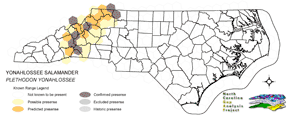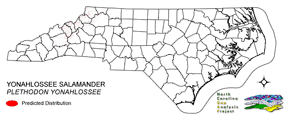
| Taxa: |
| Order: |
| Family: |
| Amphibia |
| Caudata |
| Plethodontidae |
| NatureServe Global Rank: |
| NatureServe State (NC) Rank: |
| G4 |
| S4 |
| Federal Status: |
| NC State Status: |
| --- |
| --- |


| Land Unit |
| US Fish & Wildlife Service |
| US Forest Service |
| US National Park Service |
| US Department of Defense |
| NC State Parks |
| NC University System |
| NC Wildlife Res. Com. |
| NC Forest Service |
| NC Div. of Coastal Mgmt. |
| Local Governments |
| Non-Governmental Org. |
| Other Public Lands |
| Private Lands |
| GAP Status 1-2 |
| All Protected Lands |
| Statewide |
| Hectares |
| 0.00 |
| 5,616.18 |
| 0.00 |
| 683.28 |
| 305.55 |
| 4.50 |
| 456.30 |
| 94.62 |
| 0.00 |
| 464.22 |
| 465.21 |
| 0.90 |
| 22,285.62 |
| 2,229.33 |
| 8,076.27 |
| 30,376.38 |
| Acres |
| 0.00 |
| 13,877.88 |
| 0.00 |
| 1,688.42 |
| 755.03 |
| 11.12 |
| 1,127.54 |
| 308.68 |
| 0.00 |
| 1,147.11 |
| 1,149.56 |
| 2.22 |
| 55,068.96 |
| 5,583.67 |
| 20,031.77 |
| 75,136.53 |
| % of Dist. on |
| Prot. Lands |
| 0.0 % |
| 69.5 % |
| 0.0 % |
| 8.5 % |
| 3.8 % |
| < 0.1 % |
| 5.6 % |
| 1.2 % |
| 0.0 % |
| 5.6 % |
| 5.6 % |
| 0.0 % |
| 0.0 % |
| 27.6 % |
| ----- |
| ----- |
| % of Dist. on |
| All Lands |
| 0.0 % |
| 18.5 % |
| 0.0 % |
| 2.2 % |
| 1.0 % |
| < 0.1 % |
| 1.5 % |
| 0.3 % |
| 0.0 % |
| 1.5 % |
| 1.5 % |
| < 0.1 % |
| 73.4 % |
| 7.3 % |
| ----- |
| ----- |
|
In North Carolina, this salamander occurs in the mountains north and east of the French Broad river at nearly all elevations within its range (Martof et al. 1980). In Tennessee, the range of P. yonahlossee is strikingly coincident with that of P. welleri (Redmond and Scott 1996). Yonahlossee salamanders occur in mature, primarily deciduous, woodlands of upland areas (Redmond and Scott 1996, Petranka 1998). Petranka (1998) suggests greatest abundances are in old growth forest. Typically found within 30 m of mountain streams (Petranka 1998). NATURE SERVE GLOBAL HABITAT COMMENTS: Wooded hillsides and ravines where rock slides are covered with mosses and ferns; areas with old windfalls; damp, shaded, cracked rock outcrops; grassy areas near woodlands. Found in and under rotting logs and other cover by day. Terrestrial breeder. |
| Code | Name | Description | NC Natural Heritage Program Equivalent |
| 522 | Northern Hardwoods | High Elevation forests including yellow birch, American beech, and yellow buckeye. Includes forests with Hemlock and Yellow Birch. | Northern Hardwoods Forest, Boulderfield Forest |
| 525 | Appalachian Oak Forest | A variety of oak forest types including Black, White, Scarlet Oaks in dry to mesic situations. Includes forests historically co-dominated by American Chestnut. | High Elevation Red Oak Forest, Montane White Oak Forest |
| 526 | Appalachian Cove Forest | Mixed Mesophytic forests of the mountains. Includes tuliptree, basswood, yellow buckeye and surgar maple. This class is mapped to include cove forests dominated or co-dominated by hemlock. | Rich Cove Forest, Acidic Cove Forest |
| 527 | Appalachian Hemlock | Upland hemlock forests of the moutains region. Vary from side slopes to steep slope positions. | Canada Hemlock Forest |
| 529 | Appalachian Xeric Mixed Forest | Mixed forests with Virginia, Shortleaf, Eastern White Pine, Table Mountain and Pitch pines in combination with xeric oak species. Oaks include, white, Southern Red, black, and rock chestnut. | Pine Oak Heath |
| 530 | Appalachian Xeric Deciduous Forest | Deciduous forests in the mountains dominated by Xeric Oak species. Species include, white, Southern red, black, and rock chestnut. | High Elevation Red Oak Forest, Montane White Oak Forest |
|
Guttman, S. I., A. A. Karlin, and G. M. Labanick. 1978. A biochemical and morphological analysis of the relationship between Plethodon longicrus and Plethodon yonahlossee (Am- phibia, Urodela, Plethodontidae). J. Herpetol. 12:445-454.
Petranka, J. W., M. E. Eldridge, and K. E. Haley. 1993. Effects of timber harvesting on southern Appalachian salamanders. Conservation Biology 7(2):363-370. Conant, R. and J. T. Collins. 1991. A field guide to reptiles and amphibians:eastern and central North America. Third edition. Houghton Mifflin Co., Boston, Massachusetts. 450 pp. Redmond, W. H., and A. F. Scott. 1996. Atlas of amphibians in Tennessee. The Center for Field Biology, Austin Peay State University, Miscellaneous Publication Number 12. v + 94 pp. Petranka, J. W. 1998. Salamanders of the United States and Canada. Washington DC: Smithsonian Inst. Press. Adler, K. 1965. Plethodon longicrus. Cat. Am. Amph. Rep. 18.1. Pope, C. H. 1965. Plethodon yonahlossee. Cat. Am. Amph. Rep. 15.1-15.2. Smith, H. M. 1978. A guide to field identification Amphibians of North America. Golden Press, New York. Behler, J. L., and F. W. King. 1979. The Audubon Society field guide to North American reptiles and amphibians. Alfred A. Knopf, New York. 719 pp. Martof, B. S., W. M. Palmer, J. R. Bailey, and J. R. Harrison, III. 1980. Amphibians and reptiles of the Carolinas and Virginia. University of North Carolina Press, Chapel Hill, North Carolina. 264 pp. |
For more information please contact them at:
NC-GAP Analysis Project
Dept. of Zoology, NCSU
Campus Box 7617
Raleigh, NC 27695-7617
(919) 513-2853
www.basic.ncsu.edu/ncgap